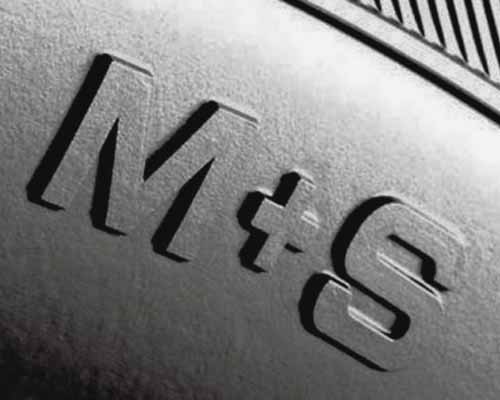Figuring out whether you have an all-season tire or not isn’t all that difficult. When you break down to it, there are certain telltale signs that clearly show whether the tire you have is all season.
There are several markings provided on the side wall of a tire that give information about the tire which includes the Uniform Tire Quality Gradings (incorporating tread rating, temperature rating and traction rating), M+S rating and 3-PMSF symbol.

There are also other physical factors that all season tires have distinctively from other tires.
These comprise of tread design of the tire, depth of the tread block and its compound material.
Find out more about the distinctive details of all season tires in the upcoming sections.
Table of Contents
M+S and 3-PMSF Rating


All season tires are M+S rated which is indicated by the M+S symbol on its sidewall.
This symbol means that the tire is rated for Mud and Snow, and it can perform well on both of these surfaces. Other types of tires (winter and summer tires) lack this symbol.
M+S rating is not a certified rating, rather it is a term given by the company.
Moreover, all season tires might also contain 3-PMSF (3- Peak Mountain Snowflake) rating which shows that it is capable of gripping on snow.
3-PMSF rating is a certified rating unlike the M+S rating.
Winter tires also have this rating, but summer tires lack it.
Tread Design
All season tires usually have a V-shaped tread block pattern in the form of a chevron.
They have an adequate number of grooves and sipes that give it a good hydroplaning resistance.
Due to its more spaced tread block it has lower rolling resistance, therefore they give better economy and greater tread wear life which makes them last up to 80000 miles.
Moreover, it has a high-density shoulder design that helps it in cornering and maneuvering.
Tread Depth
All season tires have a moderate tread depth which is more than the summer tires but less than that of winter tires. They have a tread depth of 8 to 9 millimeters (11/32 or 12/32 inches).
Due to their thick treads, they can last longer than summer tires and give a good mileage on the road.
These tires should be replaced if the tread depth reaches 2/32 inches.
There are two ways to gauge tread depth, first one is inserting a coin inside the tread block of tire to make an estimation of its tread depth.
Other way is to use a depth gauge device to get the depth of the tire directly.
The 3 Ts of Tire Rating
The 3 Ts of the tire consist of Uniform Tire Quality Grading (UTQG) that is indicated by 3 digits and 2 alphabets.
Three digits are for the tread rating, one alphabet for Temperature rating and, the other alphabet for Traction rating.
These marking are also located on the side wall of tire in a single column on top of each other.
Tread Rating
The Tread rating consists of 3 digits whose value lies in the range from 100 to 700.
One hundred being the least durable tire and 700 is the most resilient tire that provides the longest tread life.
All season tires are the tires with the longest tread life, and they have a tread rating of 600 to 700.
While other forms of tires like the winter tires have a low tread rating and they have shorter life spans.
Temperature Rating
The Temperature rating is graded into A, B or C grade.
A grade mean that the tire can withstand temperatures at speeds greater than 115 mph, B grade indicates temperature resistance in 100 to 115 mph and, C grade shows that it can withstand temperature in 80 to 100 mph.
All season tires mostly have a temperature rating of A grade, and its temperature range lies between 0° to 120° Fahrenheit or -18° to 49° Celsius.
Traction Rating
Traction rating portrays the tire’s performance on wet surfaces, it shows its ability to stop in a straight road in wet conditions and does not show its performance of cornering or handling.
Traction rating is divided into four grades, AA, A, B and, C.
All season tires normally have traction rating of A grade that indicates its ability to hold its ground in wet surfaces and being able to perform in rainy seasons.
Compound
All season tires have the rubber compound that incorporates the features of both season tires i.e., summer and winter tires.
Its not as soft as the winter tires and at the same time not as hard as the summer tires, rather it is balanced between the two.
This compound allows it to grip throughout the seasons but not as good as the summer or winter tires in their respective seasons.
Some All Season Tires Comparisons:
Conclusion
- M+S rating is a telltale sign of an all-season tire and some of them might have 3-PMSF symbol on them as well.
- They usually come with a V shaped tread block along with adequate grooves and sipes.
- Their Tread depth is usually 11/32 or 12/32 inches.
- In the Uniform Tire Quality Grading (UTQG) all-season tire has the following parameters:
- They have a Tread rating lying between 600 to 700.
- Their Temperature rating is usually A grade.
- Traction rating of all season tires is also normally A grade.
- All season tires have a semi-soft or semi-hard rubber compound.